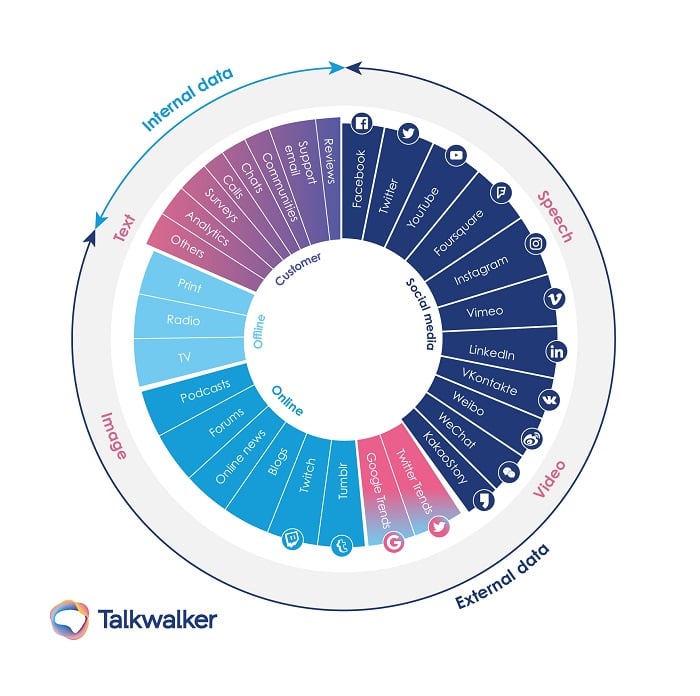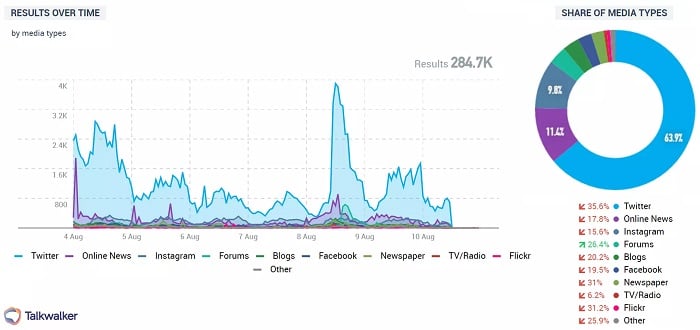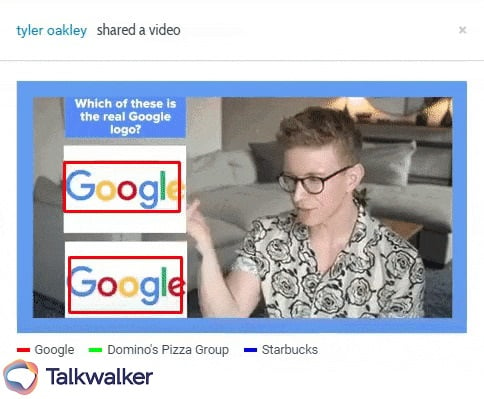Contents
- The marketing measurement challenge
- Why are marketing campaigns so difficult to measure?
- Why effectively measuring the success of your marketing will be more important than ever
- How to measure the success of marketing campaigns, in 3 steps
- The benefits of measuring your campaigns this way
- How Talkwalker can help with your campaign measurement
The marketing measurement challenge
Let’s be honest, marketing overall is a challenge to measure. In the 2022 CMO Survey, 13% of CMOs said they couldn’t show the short-term impact if marketing on their business. While 38.3% said they could only prove a qualitative sense of the impact.
That’s over half of CMOs unable to put numbers to their marketing success. Imagine how popular you could be if you could prove your marketing campaigns’ effectiveness for them.
Why are marketing campaigns so difficult to measure?
The trials of multichannel campaigns
In our new digital world, consumers are everywhere. You’re no longer in a place where one channel purely dominates your market. Instead, to make sure you’re hitting all your relevant consumers, you need to be creating for a multi-channel approach.
Consider how we promote Talkwalker’s campaigns:
- Blog posts
- Landing pages
- Organic social (Twitter, LinkedIn, Facebook, etc)
- Paid social
- PR
- Third-party content
- Webinars
- Etc, etc, etc
Each content type needs to be customized for the relevant audience, and more importantly, measured accordingly. The metrics you use to measure the impact of Twitter won’t work to measure the impact of a PR piece. Every single campaign metric needs to be measured and understood.
And that’s painful. Each metric means another solution for measurement. That could be Google Analytics for website metrics or native analytics from your social platform of choice. That’s a lot to juggle when you’re already under pressure to show results.
Metric disparity
Once you have all that data, how do you pull it together?
As each content type has its own set of metrics, you’re stuck trying to understand how pieces work as a whole. Is a view of a blog post the same as a view on Twitter? Can you measure the engagement of those channels equally?
Somehow you need to standardize all that data, to get a true picture of your campaign and how your audience reacted to it.
Most importantly, proving to those above you what worked
Going back to what I said earlier, every dollar spent needs to bring back a return. All those metrics above need to be tied to what matters most to your business - the bottom line. Huge engagement on your latest Reel is all well and good. But are those viewers then connecting with your brand and spending money?
In a recent Forrester analysis, 71% of B2C marketing execs said that demonstrating the value of marketing would be challenging in 2022.
But you need to, to justify your work and strategy.
Why effectively measuring the success of your marketing will be more important than ever
Sorry to be a downer, but this isn’t going to get any easier. Instead, it’s probably going to get much worse.
More social channels
People are diversifying where they are spending their time on social media. New channels crop up each year, and there’s always one the C-Suite thinks you need (looking at you, TikTok). Each new channel means more metrics to juggle.
More consumer mediums
And these channels give consumers more ways to engage with your brand. You could focus on when your brand is mentioned in text. But what about when people share your logo in a video, Tweet a product image, or discuss you in a podcast? Consumers are finding new ways to engage, and you need to find the right content to resonate on these channels.
![]()
Not everyone writes about your brand. Logo detection can help you find your brand mentions in images. Talkwalker Social Listening and Consumer Intelligence Platform.
More cost-effectiveness
If you thought the pressure was tough before, consumer spending is on the decline. There’s a significant risk of a recession, and teams are being reduced. You need to prove your worth for every single campaign, and that means showing exactly how much profit it brought in.
How to measure the success of marketing campaigns, in 3 steps
Note: This method requires the help of a social listening platform. If you’re new to social listening, or need a refresher on what it can do, read this blog first.
Otherwise, here’s our robust methodology for measuring campaign success, in three simple steps.
1. Discover all your mentions
To measure your success, first of all you need to find the true voice of your consumer. That means getting all those mentions, all those metrics, in one place.
That’s why you need a social listening platform. This can automate the gathering of all your data for you.
For the broadest coverage, you need to include:
Social media mentions
Social media is where most consumer conversations happen. Your data should include earned, owned and paid brand mentions from a wide variety of social channels, along with metrics relating to those channels.
Website, news, and blog mentions
To measure how your campaign messaging is shared, you need to include mentions from across the web. This will help monitor how consumers and the press are sharing your campaign.
Multimedia mentions
As mentioned above, the internet is not just about text. Include in your mix multimedia mentions of your brand, whether that’s in videos, pictures, audio, or more. This will provide a more comprehensive voice.
Review data
Reviews provide a more direct method of feedback from consumers. By including review data in your mix, you can see if your campaign has directly impacted what consumers say about you and your products.
Survey data
While not as immediate as social data, surveys can provide you with a curated view of your consumer opinions. Include these if you want more nuanced insights into your campaign responses.
Web analytics
For all of this to work, you should be able to tie all these efforts into online brand impact. Therefore you need to include data from services like Google Analytics. This can help identify the correlation between your efforts and the leads generated.
Custom data
I can’t list here everything, especially as your data needs could change depending on your own business or marketing strategy. The ability to add additional data sources into the mix as you need can help solve this.
An example of the data sources you can integrate into Talkwalker’s platform.
2. Analyze what’s relevant
Now you have a true view of your consumer. But that means you have a lot of data to be turned into insights. How do you find those valuable needles in all that straw?
Luckily, you’re not alone. This is where AI comes in. Imagine it as a superpowered assistant. It’s more than happy to do all the longwinded, complicated, time-consuming tasks that you don’t want to. These can include…
Data segmentation
Say you want to split your results by specific campaigns, regions, or demographics. AI can help pull all those relevant mentions together, as they happen. This gives you a complete understanding of your campaign impact. And also identifies if your campaign has resonated further than your intended audience.
You can also compare if/how different efforts correlate within a campaign. Did your paid social cause an uptick in organic social mentions? Now you know.
Sentiment analysis
Forget all news is good news. Sentiment analysis is used to identify how people feel about your brand, turning quantitative data into qualitative. A thousand mentions of your business isn’t good if all of them are complaints. Sentiment analysis helps you understand if a brand mention is positive or negative, to give you a broad overview of your campaign perception.
Entity-based sentiment can dig even deeper to discover what consumers think specifically about keywords (products, brands, etc) in that mention.
Insights in seconds
Even with all these advantages, you still need to take a look at the data, to get even more quantitative insights. If only an AI could read them all for you, and provide you with a summary of what is said…
Well, it can. By bringing the power of GPT to social listening, AI can now give you a few concise sentences that sum up what people were saying in all your review, survey, or email data.
All of this takes all the data you have, and makes it easy to manage, more relevant, and quick to understand.
3. Act on the results
Great. You have a nice segmented set of results, with true insights into just what your consumers are thinking. Now you need to look at some key performance indicators (KPIs) to measure your success across your campaigns. Here are some that we use to measure how our campaigns have performed.
Brand sentiment
People buy from brands they love, with research showing that brand love helps drive loyalty, word of mouth, and willingness to spend more. Every campaign you do should boost your brand love within the minds of your consumers.
Sentiment analysis helps you measure this brand perception over time. You should use it to understand both:
- The sentiment of the campaign.
- The overall sentiment of your brand.
In theory, a great campaign should have high positive sentiment, and boost your overall brand sentiment. If that’s not the case, maybe the campaign didn’t tie into your brand well enough, or did run long enough to have a brand impact.
You can also combine sentiment analysis with your NPS™ (Net Promoter Score). Your NPS is a quantitative measurement that quickly helps your understand your brand health. Sentiment analysis can provide the qualitative analysis to help you understand the reasoning behind that score.
Message uptake
Before you start a campaign, define the key takeaway you want consumers to learn from it. That might be a catchphrase, a feeling, a keyword, whatever. To measure the campaign success, you want to look if that key takeaway was adopted by your audience.
For example, if Coca-Cola wanted to emphasize their refreshing nature in their next campaign, they should be looking for an increase in branded consumer conversations around refreshing.
An example of how your brand message can be absorbed and shared by consumers.
Outside of your campaigns, you should also translate your brand mission/vision into a consumer language, and see if consumers are using those keywords when they discuss you. If they are, that’s another sign of success.
Share of voice
Share of voice (SOV) can correlate to market share - if your share of voice is greater than your share of market, you’re more likely to gain market share. Simply put, the more that people talk about your brand, the more likely they are to buy it.
The formula for share of voice measurement is fairly simple:
(All your brand mentions/All your industry mentions) x100
This is where the true voice of the consumer is critical. If you’re missing a data source that is driving a lot of industry conversations, your score will be distorted.
The best campaigns should boost brand conversations enough to up your SOV. But bear in mind, your competitors will also be trying to do the same, so you need to continually measure their campaign responses too.
Traffic/conversions/sales
Depending on your business goals, this could be measured in several ways. The most straight forward is to look for a correlation between campaigns and traffic. This is much easier for digital businesses by using data from Google Analytics, but you can also measure footfall in-store.
However, to prove the real value of your campaigns, there are other metrics you can consider.
- MQLs/SQLs - Did your campaign directly generate marketing qualified leads or sales-qualified leads?
- Conversion rate - For direct marketing, what percentage of those engaged converted into leads/sales?
- Sales - By including your sales data into your true voice of the consumer, can you see a correlation between the campaign and your numbers?
Once you have these figures, and ideally have assigned a monetary value generated by the campaign, you can measure success through several numbers.
- ROI - Return on investment. The money you generated compared to the cost of the campaign. The higher the ROI, the better the campaign.
- CAC - Customer acquisition cost. This is a more detailed way of measuring ROI that takes into account all the related costs associated with the campaign, such as employee costs and overheads. The lower the CAC, the better.
The benefits of measuring your campaigns this way
This method helps turn campaign analysis into hard numbers, which means you can:
Track your success over time
By measuring all your campaigns the same way, you can benchmark your success, and see how all your campaigns compare across all channels. This way, you can identify what is resonating with your consumers, and enables you to replicate your success in the future.
You can also monitor competitor campaigns in the same way, allowing you to benchmark your success against theirs.
By bringing all your campaign data into one platform, you can get a true view of your campaign effectiveness. Talkwalker Social Listening and Consumer Intelligence Platform.
Track your success across demographics
By having a consistent methodology on a global scale, you can compare campaigns by region, by audience, by time, etc. Ensuring that your campaigns are most effective for the consumers you’re targeting, while also highlighting if there is a particular audience being missed.
Outperform your competition
By monitoring your campaigns in real time, you can adapt almost instantly. Creating more personal, impactful campaigns every single time. This constant measurement with clever optimization will help you outperform your competition at every step.
Proves your value to the company
As numbers are crunched, companies want to make sure every department is proving its worth. Successful campaign measurement such as this, helps you prove the financial benefit of the campaigns you’re running, leading to a more stable and (hopefully) rewarding career for you.
Save time
By organizing all your data through one platform, with the support of AI, you can cut down on the hours needed to review every campaign element. If you can add in an automated reporting process into this, end-of-month and end-of-year reporting can be done quickly with minimal effort.
Optimize your budgets
Similar, when budgets are cut, it can help identify areas where you can spend more efficiently. It may be that a paid Twitter campaign creates more buzz, but when you crunch the numbers, you could discover your organic YouTube videos actually deliver better conversion. And then you know exactly where to cut without impacting your success.
This way you can post the right content for the right people on the right platforms at the right time.
How Talkwalker can help with your campaign measurement
This method does sound simple. But with the right social listening platform, it really can be. Talkwalker’s Social Listening and Consumer Intelligence Platform brings some extra-special capabilities that can help make your campaign measurement even simpler and faster.
Visual analytics
Talkwalker’s visual analytics helps uncover all the mentions of your brands (and competitors), to help you get a true voice of the consumer. Not only can you find textual mentions of your brand, but you can also:
- Find your logo in images and videos across social media.
- Detect brand mentions within Twitter audio using Talkwalker’s Speech to text AI. (Only available in Talkwalker).
- Identify brand mentions in podcast audio.
- Use OCR (Optical Character Recognition) to detect text written in any image. (Only available in Talkwalker).
This means when you analyze your SOV, you know it’s not missing anything.
An example of how you can detect logos within videos. Talkwalker Social Listening and Consumer Intelligence Platform.
Sentiment analytics
Talkwalker’s sentiment analysis currently covers 92 languages, providing you with the sentiment for your posts no matter where your consumers are. It can also interpret human emotions and basic types of irony and sarcasm.
It’s adaptable. With entity-based sentiment, and customizable AI models so you can set your own individual sentiment definition.
Automated reporting
The above methodology can all be automated into a regular report. Custom business impact metrics enable you to display external data within the report, so for example, you can compare your metrics against sales figures for the above analysis.
You can also automate alerts, so if a campaign goes wrong and your brand sentiment starts to drop, you can be alerted, instantly.
Conclusion
Campaign measurement is just one way Talkwalker is making it easier for marketers to do their job. To see this process in action, and discover how easy it is to measure your campaigns more effectively, download our free campaign management dashboard template below.






